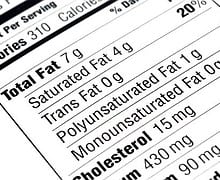Make sense of servings sizes, daily values and more
If the “Nutrition Facts” label on the side of your box of spaghetti or jar of juice reads like a foreign language, you’re not alone. But reading and understanding those labels can help you make healthier food choices.
The Serving Size
When you look at the Nutrition Facts label, start at the serving size and the number of servings in the package. Serving sizes are standardized to make it easier to compare similar foods; they are provided in familiar units, such as cups or pieces, followed by the metric amount.
Pay attention to the serving size, especially how many servings there are in the food package. If the label says one serving equals one cup, and there are two servings of food in the package , you’d consume two cups if you ate the whole package. That doubles the calories and other nutrient numbers, including the %Daily Values.
Calories
Calories are a measure of how much energy you get from a serving of this food. Many of us consume more calories than we need without meeting recommended intakes for other nutrients. The calorie section of the label can help you manage your weight.
Two things to note: 1) Most calorie guides on Nutrition Labels are based on a 2,000-calorie-per-day diet, and 2) eating too many calories per day is linked to overweight and obesity.
Nutrients
Limit These
The nutrients listed first are the ones Americans generally eat in adequate amounts—or even too much. Eating too much fat, saturated fat, trans fat, cholesterol, or sodium may increase your risk of certain chronic diseases, like heart disease, some cancers and high blood pressure.
Get Enough of These
Most Americans don’t get enough dietary fiber, vitamin A, vitamin C, calcium and iron. Eating enough of these nutrients can improve your health and help reduce the risk of some diseases and conditions. For example, getting enough calcium may reduce the risk of osteoporosis. Eating a diet high in dietary fiber promotes healthy bowel function. Additionally, a diet rich in fruits, vegetables and grains that contain dietary fiber, particularly soluble fiber, and low in saturated fat and cholesterol may reduce the risk of heart disease.
The Footnote
The * used after the heading “%Daily Value” on the label refers to the Footnote in the lower part of the nutrition label, which tells you “%DVs are based on a 2,000 calorie diet.” This statement must be on all food labels. But the remaining information in the full footnote may not be on the package if the label is too small. When the full footnote does appear, it will always be the same. It doesn’t change from product to product, because it shows recommended dietary advice for all Americans; it is not about a specific food product.
The Percent Daily Value (%DV)
This one is simple 5%DV or less is low and 20%DV or more is high.
The Latest Nutrition Labels News
Now that we’ve given you a primer on understanding Nutrition Labels, we’d be remiss if we didn’t tell you that recent research says calorie tallies may be wrong. Experts have been calling for an overhaul of the system for some time, saying the calorie counts are estimates only. But the inaccuracies are relatively small and are usually overestimates, so if you’re trying to lose weight, you should be fine.






